One of the most popular NAS units from Synology is the DS918+, which was released over 3 years ago. The popular platform is finally getting an update with the new Synology DS920+ 4-Bay 1GbE NAS. It would be easy to mistake the product image with a DS918+ as they look almost exactly alike. The main differences with the DS920+ come down to labels and the processor. The new DS920+ features an Intel Celeron J4125 Quad-Core processor at 2.0GHz, which can burst up to 2.7GHz. This offers up a solid speed improvement with the new generation. In our review, we are going to see the impacts.
Synology DS920+ 4-Bay 1GbE NAS Overview
The front of the Synology DS920+ holds four 3.5″ drive bays. In the world of NAS units, the number of 3.5″ bays is often one of the biggest selection criteria.
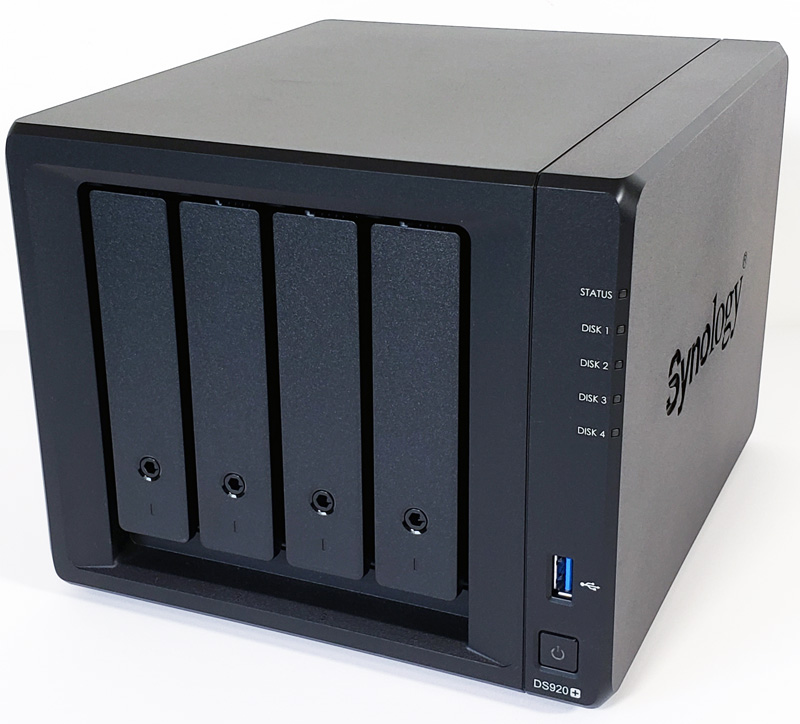
For the drives, Synology uses a tool-less design, but there is still a tray involved. This is easy to put together. When the tray was first introduced, it was one of the easiest and most innovative in the industry. Now, many traditional server vendors have innovated and are offering tool-less drive trays with robust designs.
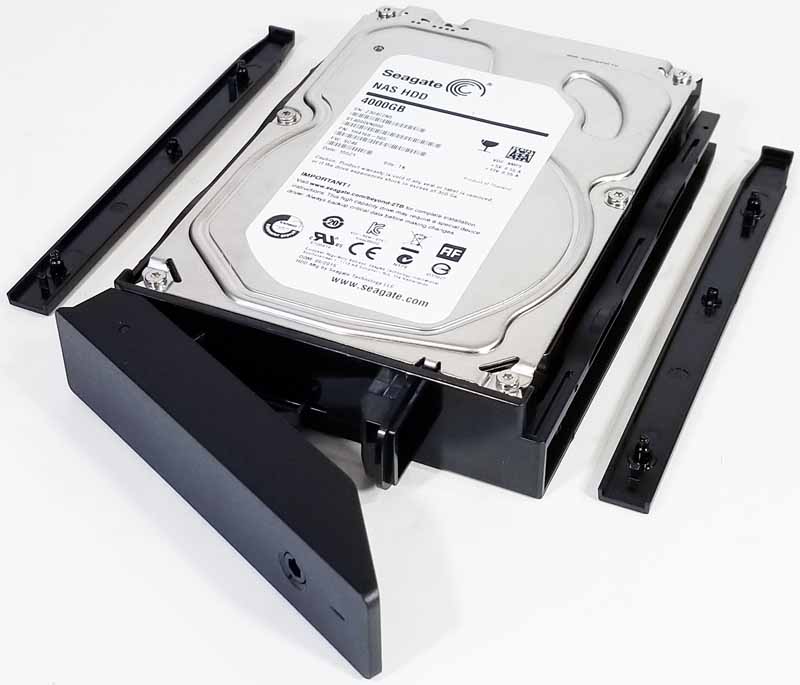
Let us highlight the changes between the DS918+ and the newer DS920+.

Another difference between the DS918+ and DS920+ is how the RAM is configured. The DS918+ allows both RAM modules to be easily replaced from the inside of the NAS bay. The DS920+ comes with one 4GB RAM module installed inside the NAS, and only one RAM slot is accessible through the HDD bay. Looking inside the HDD bay we see that the extra RAM slot can be accessed without to much trouble. You can see the linked DS918+ piece for the older version of this design.
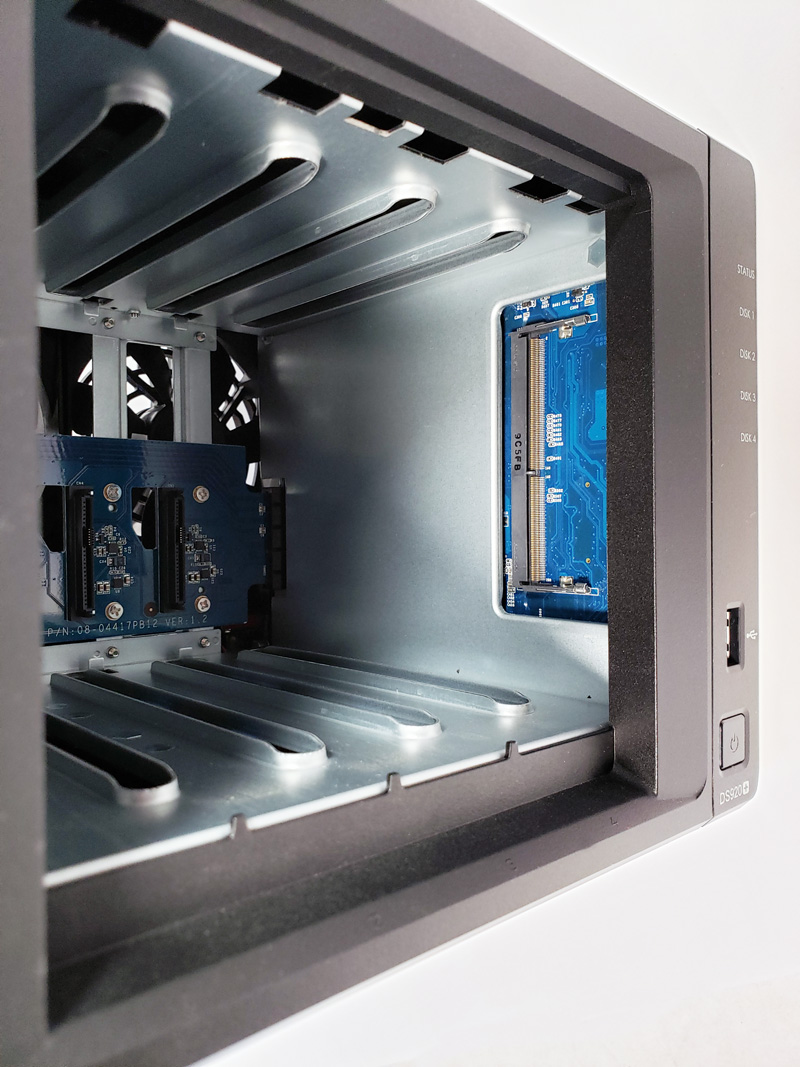
Accessories included with the Synology DS920+ 4-Bay 1GbE NAS include
- Quick Installation Guide
- AC Power Cord
- AC Power Brick (100W)
- 2x RJ-45 LAN Cables
- 1x Package Flat Head Screws for 2.5″ HDD’s
- Tray Lock Keys
The back of the DS920+ is slightly different than the DS918+, which is mainly the location of the Kensington Security Slot. The cooling fans on the DS918+ are held into place by a bezel. These can be removed without taking the case off the unit. Here we see the cooling fans on the DS920+ secured on the inside of the case.
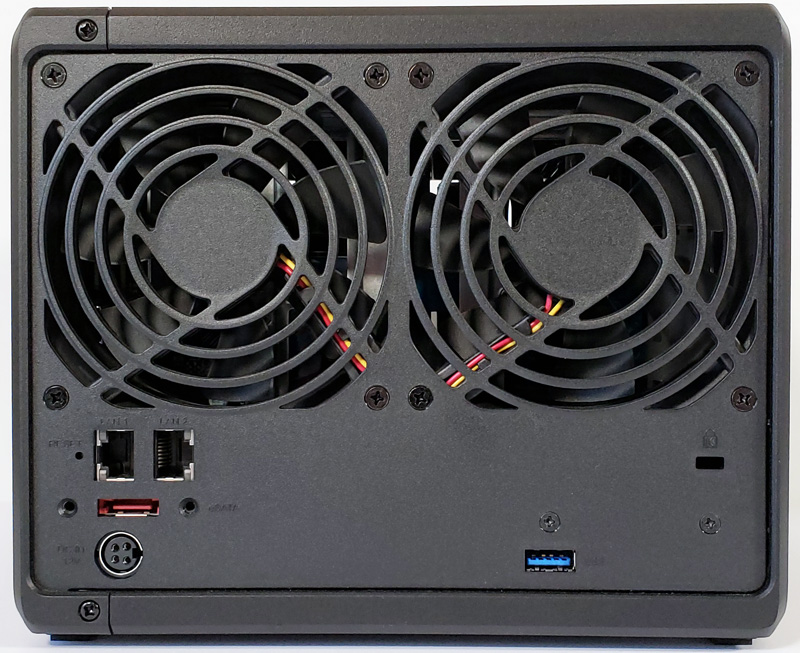
Something we were hoping for in a 2020 update is 2.5GbE or 10GbE. The industry is moving that direction in a big way this year and 2.5GbE controllers are relatively inexpensive compared to the cost of the NAS. This was an area that Synology should have innovated on. 2.5GbE is backward compatible with 1GbE so existing users on 1GbE would have the same capability with the ability to upgrade later.
Like the DS918+ we find two M.2 NVMe SSD expansion slots at the bottom of the DS920+ which are used for caching purposes, they cannot be an additional volume.
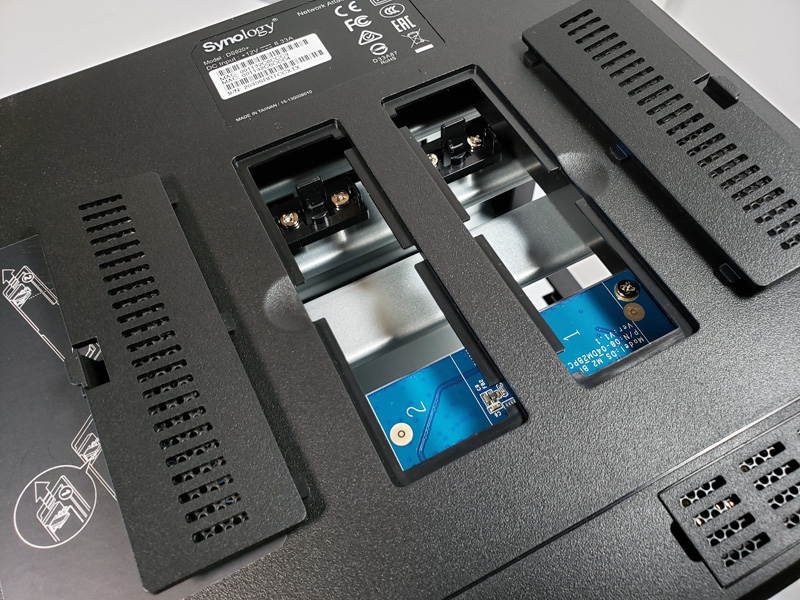
Let us move on to the hard drives we used with our unit.
We Used Seagate IronWolf and Warning for WD Red Hard Drives
We have started using Seagate Ironwolf 4TB HDD’s in our NAS testing for about a year now. These are solid performing HDD’s with the Ironwolf brand used for NAS units.
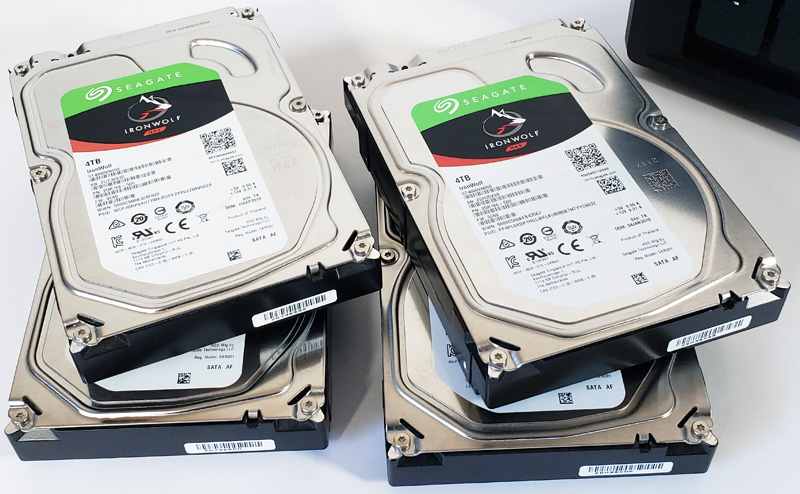
Notably, Seagate confirmed that these are still conventional magnetic recording or CMR drives.
Recently it was discovered that WD surreptitiously swapped SMR into the WD Red line using a technology called drive managed SMR or DM-SMR. We tested the new WD Red SMR vs CMR using ZFS NAS units and found they were unsuitable. After this story broke, Synology disqualified the WD Red DM-SMR drives from their NAS lines as we heard Synology owners were impacted too. You can learn more about that in our WD Red DM-SMR Update 3 Vendors Bail article. If you prefer the video version, this will help you get caught up.
For generations, we had recommended WD Red or Seagate IronWolf often based on price. The 256MB cache 2-6TB WD Red “EFAX” drives should be avoided in this and other NAS units.

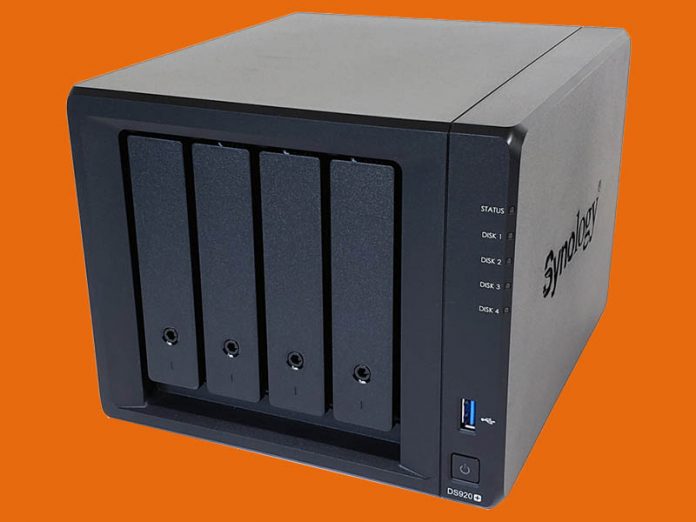


Given the lack of 2.5 GbE I cannot see how you can give such high score. It is nice to have upgradable RAM and NVMe slots, but this NAS is definitely limited by 1 GbE only.
Seeing that this year’s motherboards (both AMD B550 and Intel Z490) are moving to 2.5 GbE more or less as standard it is a shame to not include it in a medium-range 2020 NAS.
Disclaimer: I have owned two Synology NASes over the years. Currently I am running a FreeNAS machine. I really like Synology for their ease of use, but the prices are high for the hardware you get.
Same for me. I was looking into replacing my DS214PLAY. Yes this will be much faster, but not multi-year future proof.
I’ll wait untill QNAP releases its hero OS and look for a 4disk+2,5GBE prosumer nas there.
If you’re happy to give up the USB 3 port, you can install custom drivers and use a 2.5GBE or 5GBE Ethernet to USB adapter.
@Ned Yes that is certainly an option, but it’s annoying that Synology didn’t pay the $2 to $5 cost to have it integrated.
Unfortunately I have to agree with the previous comments : I like the Software but I don’t understand, why the HW is that limited. The price can’t be the reason. In case of the 220+ the memory upgrade options are worse than with the 218+ due to the soldered memory. The processor power is useful for virtual machines but with that little memory? I will stay with my 218+ /16gb machine
Comparing this to the new QNAP TS-431X3 and QNAP TS-431KX it’s obvious that Synology is nickel-and-diming their NAS lineup to prevent the cheaper options to cannibalize the more expensive SMB lineup in an artificial manner. With current HDD capacities not being meaningfully different for most purposes it’s sad to see that Synology is artificially segmenting their lineup to protect the likes of DS1618+ or DS1817.
in all the STH performance tests it’s obvious that the bottleneck is 1GbE.
@Wannes take a look at the above mentioned QNAP models, I’m getting either of those optiosn as soon as they’re in stock locally to me to replace a DS213
The SoC upgrade seems pointless when limited by 1gb networking. Even the lowest targeting market (home users wanting their first NAS) are starting to upgrade to 2.5 and beyond.
To jump on the bandwagon of 1GbE; having never owned a Synology but looking to buy a system, can the two interfaces be aggregated? If I have a managed switch supporting LACP, can I at least get 2Gb throughput (understanding the limitations of TCP sessions)?
@Hans Schober: Yes, you can aggregate the two 1GbE interfaces into a single LACP channel (bond).
@Hans Yes, but if you aggregate the two 2,5 links on a QNAP or asustor you’ll get 5gbps :)
In the hopes that someone from Synology will eventually see these comments and see how incredibly painful this whole 1GbE issue is, I’m going to jump on the bandwagon. I also switched over to FreeNAS, but desperately want to switch back for lower power consumption and ease of use. They know their OS is great, but hey, if QNAP ever comes out with something better (I see someone mentioned hero OS, will have to look into that), Synology will be a thing of the past. This nickel and dime mentality they can’t seem to get over is the reason I will always put my $1k else where. Sorry Synology, get your head right.
I agree with you guys. I hope Synology reads the review and comments.
You can LACP two ports, but this is a low-end NAS meant for SMB. 2.5g is incredibly more useful than 2 1g ports.
I get why it only has 1Gbe in that ifs an inexpensive solution to NAS often installed on 1Gbe networks. My issue with Synology is the cheap software. People rave about it but in the end they cut so many corners and their solution often feel half baked. DSM 7 may fix this but its been delayed for more than a year. Their warranty is painful at best and their prices are high for the name. Overall I’m surprised this scored more than a 6.0.
It seems a little unfair to compare the Synology DS920+ against the aging Qnap TS453A when the 2020 TS453D has been released.
Bother units use the same processor and the 453D adds 2.5Gbe connectivity.
Might be worth updating the charts to compare these to see how they stack up.
Why would a home user need a 2.5Gbe connection? Almost all devices will be 1Gb or lower connections. I don’t consider this a high end NAS, it’s more for streaming media/backup in your home. I don’t own anything that could take advantage of a 2.5Gbe connection. I get that some people have some equipment that could use it, but I think it will be years, until it’s common. The TVs out now in 2020, still have 100Mb connections!!
This review is very useful and share insight. Specially features are explained in details.
“Why would a home user need a 2.5Gbe connection [if] Almost all devices wil lbe 1GB or lower [?]”
A NAS is likely to be simultaneously accessed by multiple devices. If one TV, two PCs, and several torrents are all trying to use the same 1Gbe connection (from a 4 HDD array) then the network connection becomes a bottleneck preventing at least one of those clients from achieving maximum potential throughput.
Future-proofing is a significant concern now (versus 5 years ago). I’ve run Cat6a in my house. If I’m spending $500+ CAD on a NAS, limiting myself to a pair of 1Gbe connections is a real no-go.
This assumes there’s an affordable 10Ge switch for the home user and we’re not there yet. Yes, there are 10GE switches available but most home setups today are on 1Ge networks.